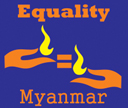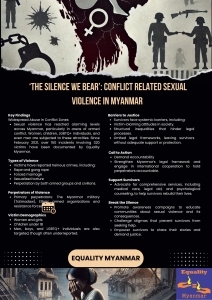The Silence We Bear’: Conflict Related Sexual Violence in Myanmar
Executive Summary
The ongoing conflict in Myanmar has led to widespread and severe human rights violations, with conflict-related sexual violence (CRSV) standing out as one of the most alarming and pervasive issues. The current conflict in Myanmar began in February, 2021 after a coup led by the military junta or State Administration Council (SAC) overthrew the democratically elected government led by Aung San Suu Kyi and the National League for Democracy (NLD) citing unsubstantiated claims of election fraud. This was followed by massive nationwide protests, strikes, and a brutal crackdown on civilians by security forces[1]. Women and girls have been particularly vulnerable during this period, as the military’s widespread use of violence and intimidation tactics have included widespread sexual violence. According to the UN Secretary-General’s 2022 report on conflict-related sexual violence, over 25 verified cases of sexual violence were committed by the military (Tatmadaw) against women and girls. However, the actual number of cases is likely much higher, reflecting the under reporting and fear of retaliation that survivors face.
This situational report provides a critical examination of conflict-related sexual violence (CRSV) in Myanmar, shedding light on the pervasive patterns of abuse and the harrowing realities faced by survivors. Drawing on testimonies from local civil society organizations (CSOs) and human rights defenders (HRDs), it prioritizes the voices of survivors while contextualizing these violations within Myanmar’s ongoing conflict and systemic gender inequality. The key objectives of this study have been to identify the prevalence of CRSV in Myanmar, understand who is perpetrating these acts as well as highlight the legal gaps in addressing and preventing CRSV in the context of Myanmar. The findings demonstrate that sexual violence remains widespread throughout the country and has included acts such as rape, gang rape, attempted rape, sexual harassment, forced marriage, and forced prostitution. The primary perpetrator are Tatmadaw (from the SAC), and individuals from People’s Defence Forces (PDF), various ethnic resistance organization and ethnic revolutionary alliances (ERO/ERA). However, civilians have also been implicated as perpetrators of sexual violence. Victims are predominantly female but also include males, LGBTQ+ individuals, and children under the age of 18. It should be noted that the research revealed that children, primarily girls, were frequently targeted for sexual violence by members of various armed groups. However, incidents of such violence perpetrated by civilians were also documented, highlighting the pervasive nature of this abuse.



